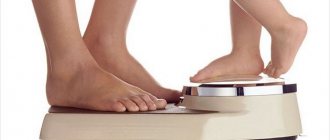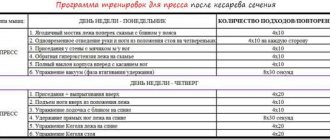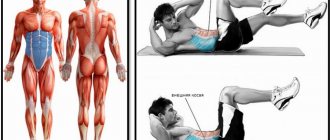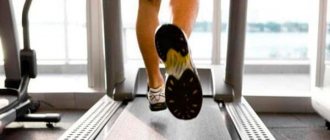Every woman wants to have an ideal figure.
Therefore, the question often arises of how to pump up abs for girls after a caesarean section; videos on the Internet will help with this.
Of course, restoring your figure is not at all an easy task and requires a lot of effort and time.
Because during pregnancy, muscles stretch very much, causing weight gain and fat deposition.
It’s rare for a woman to quickly return to normal after giving birth. Typically, the stomach becomes saggy and the skin looks loose.
From the outside, all this will resemble shaking jelly.
Therefore, you should pull yourself together and exercise at home. This is the only way to achieve a beautiful figure and a flat tummy again.
Is it possible to pump up abs after a caesarean section?
During pregnancy and some time after childbirth, the female body undergoes a number of serious changes:
- the skin stretches;
- the tone of the muscles of the abdominal wall changes: the tissues diverge, overstretch, weaken;
- Fatty tissue is deposited in the abdominal area.
All this leads to an increase in the volume of the abdomen, which does not subside even after delivery. The abs after a cesarean section do not look their best also because of the presence of a suture on the abdominal wall.
Internal changes in the reproductive system during this period are no less serious. For several weeks, the uterus remains enlarged, gradually shrinking and returning to its previous position under the influence of hormones. Before the end of its involution, lochia leave the genital tract: fragments of the mucous membrane that lines the cavity during pregnancy. This process usually takes 5–6 weeks, during which the woman is not recommended to overload herself physically. Recommendations to carry a baby in your arms for several hours or to start sports activities 3-4 weeks after birth are illiterate. All that can be achieved in this way is prolapse of the internal organs. Attempts to play sports almost immediately after abdominal surgery are a real mockery. Until the suture is completely healed and its consistency is checked by a doctor, any muscle tension can be fraught.
Whether it is even possible to pump up the abs after a cesarean section depends on the type of operation, the general health of the woman, the presence of postpartum complications and other factors. In cases where the cause of abdominal surgery during childbirth was a serious illness: retinal detachment, hypertension, heart disease, renal failure and a number of others, intensive exercise may be banned for life.
The worst thing you can do is start listening to the “recommendations” of your husband, girlfriends, acquaintances and other well-wishers. The aesthetic preferences of loved ones and strangers is not a reason to put your own health at risk. Advice to wear a baby in a sling, sleep exclusively on the stomach, or run to the gym with weight training equipment before the seam completely heals can deliver the unlucky mother straight to a hospital bed. In such a case, concerns about the beauty of the figure will have to be put off for a long time, since instead you will have to think about how to survive.
What you should absolutely not do
Until you get your doctor's permission to exercise, you should not try to remove belly fat using other methods.
- Diets. It is absolutely unacceptable to go hungry or follow the most severe diets, because when caring for a newborn, it is extremely important to adhere to rational principles of nutrition. To obtain nutritious and healthy breast milk, a woman needs to eat well.
- Binge eating. Some mothers go from one extreme to another - since you can’t lose weight yet, that means you can eat to your heart’s content. Such overeating will lead to rapid growth of the belly, which will be quite difficult to remove. Therefore, foods rich in fat and high in calories should be excluded from the mother’s diet. It is better to take steamed vegetables, fermented milk products, chicken breast, yoghurts and fruits as a basis.
- Do not violate medical recommendations. It is better for a specialist to know when after a cesarean section you can start pumping up your abs. And premature loads will only do harm.
And remember, the minimum possible loads are allowed no earlier than 3-4 months after a cesarean section, and it will be possible to strain the abdominal muscles only after six months.
When can you pump up your abs after a caesarean section?
The period when you can pump up your abs after a cesarean section depends, first of all, on the success of the recovery period. Rehabilitation occurs faster at a young age - up to 30 years, after the first such operation performed as planned. In these cases, you can start your first classes after 4 months.
It takes longer to recover after a repeat cesarean section, during multiple pregnancies, and in some cases after emergency intervention after unsuccessful attempts at natural childbirth. Depending on each individual case, the postoperative suture becomes stable no earlier than after 5–6 months. Increased stress on internal organs and skin contributes to slower recovery.
After how many months did your doctor allow you to pump up your abs?
5more than 6
Complicated operations with gestosis, massive blood loss, subsequent curettage of the uterine cavity, suppuration of the suture and other pathologies delay recovery up to 12 months or more. It is impossible to determine in advance how many months after a cesarean section you can pump up your abs in such cases. This is decided based on the results of a medical examination.
If the healing of the suture is successful, and the health of the young mother is normal, from the second month you can gradually begin to increase physical activity. There can be no talk of any sports during this period, but long walks will help strengthen the muscle walls. With your doctor's permission, you can go swimming or skiing.
To maintain muscles in the initial period, it is recommended to wear a correction bandage after cesarean section in the form of an elastic belt. It should prevent the abdominal wall from sagging, but not tighten or squeeze the abdomen.
How to do the vacuum exercise after childbirth
There are two main principles for performing the exercise:
- It is better for young mothers to do the “vacuum” while lying down. This position will reduce the load on the rectus abdominis and pelvic floor muscles. Another convenient option would be the cat position.
- The vacuum itself is created by taking a very deep breath: you need to pull in your stomach as much as possible, literally hiding it under your ribs.
Prepare a comfortable place for gymnastics. It is best to cover the floor surface with a gymnastic mat or soft blanket.
Legs should be bent at the knees. Press your feet firmly to the floor and spread your arms wide to the sides.
Prepare your breathing: take several calm breaths in and out.
Pay attention to how your chest moves when you breathe: as you inhale, your ribs move apart, your stomach rises; as you exhale, the ribs slowly return to their original position, and the stomach relaxes and lowers. Now you need to do the following: when the ribs spread freely when inhaling, you should not allow them to return to a calm state, but try to spread them as wide as possible
Now you need to do the following: when the ribs spread freely when inhaling, you should not allow them to return to a calm state, but try to spread them as wide as possible.
The stomach will “disappear” under the ribs.
Perhaps this exercise will not seem so simple for the first time. But over time, you will learn to do it correctly and control your breathing.
Having become familiar with the main provisions of the technique, you can perform gymnastics in other poses: standing or on all fours.
You can pull in your stomach using this principle even at your workplace.
This exercise is by no means a universal method of body correction after childbirth. Gymnastics is an effective tool that, in combination with diet and other exercises, will help bring even more health benefits to a young mother.
This video will help you understand even better how the vacuum exercise is performed:
Recommended abdominal exercises
When trying to regain physical shape, you should not chase quick results. When looking for ways to pump up your abs after a caesarean section, you should not forget about other muscle groups. It is recommended to create an individual training program, gradually introducing new complexes into it. Versatile aerobic and strength exercises contribute to the rapid burning of fat, strengthen muscle fibers, and improve metabolic processes.
It is advisable to start classes with an instructor in the gym. The leader will monitor the amplitude, dosing of loads and correct execution. If this is not possible, you can set up a place at home, preferably in front of a large mirror.
General rules
The basic principles of productive exercises to regain a slender torso are easy to remember:
- The load should be increased gradually. It is required to start classes with a long warm-up: dancing, walking, running in place. To warm up your muscles, you can work on a stepper or treadmill for 10–20 minutes. A signal that you can begin the main part of the exercise is an increase in heart rate, a feeling of internal warmth, and a surge of energy. At the end of your workouts, it is necessary to stretch to prevent cramps and restore normal blood circulation in the tissues.
- At home, doing abdominal exercises after cesarean section is necessary for 10–15 minutes continuously. The number of repetitions should be in the range of 10–30. Rest between exercises - no more than 1 minute. This will allow you to mobilize your strength and achieve better results.
- You need to exercise regularly. Ideally - every other day, with minimal loads - at least 2 times a week. Short workouts of 15–20 minutes will be more productive than torturing the body for several hours, but occasionally.
- You cannot perform exercises with a full stomach. It is optimal to start training 1.5 hours after eating.
- Breastfeeding mothers should exercise after the next breastfeeding, and not before feeding. Breasts filled with milk will cause physical discomfort, which will not have the best effect on your well-being. Sudden movements and tension can provoke subsequent stagnation and the development of mastitis. Exercising after feeding or pumping, on the contrary, will help improve lactation.
It is not recommended to use a child as a sports equipment during exercise, especially at first. With awkward movements or as a result of fatigue, there is a risk of injuring or frightening the baby. In some children, shaking and twisting of the body can cause digestive problems or colic. Active games with the baby are useful and necessary, but you should not combine them with the mother’s sports activities.
In the second year of a child’s life, joint activities can be practiced, but a specialist must show how to do it correctly.
A set of exercises for abdominal training
As part of each lesson, it is necessary to use all groups of abdominal muscles: upper, lower abs, oblique muscles. It is recommended to start the complex after the warm-up is completed with breathing exercises:
- sitting on a chair or standing in front of a mirror, lower your head down so that your chin touches your chest, place your palms on your lower abdomen, lean forward slightly;
- inhale slowly and deeply, sticking your stomach out as much as possible, hold your breath, counting to 5;
- exhale sharply, simultaneously drawing the abdominal wall inward as far as possible so that the costal arches protrude, hold your breath again for a count of 5.
After resting for a few seconds, repeat the exercise. Then you can complicate it: after the next exhalation, push forward and retract the abdominal wall several times. The result of gymnastics will be the activation of blood circulation and a better flow of oxygen to the muscles.
Abdominal exercises after cesarean section:
- Sitting on a chair, resting your hands on the seat and straightening your back. Raise your knees bent, pulling them as close to your chest as possible. Do not change the position of your back: do not tilt it back or slouch.
- Lifting the buttocks. From a lying position on your back with straight arms extended along the torso, legs bent at the knees with support on the feet. As you exhale, bend at the waist and push your pelvis up, resting your elbows on the floor. Raise your buttocks as high as possible, pulling your stomach inward. Without stopping at the top point, lower your pelvis, but do not touch the floor, raise it again.
- Lifting the upper body. Lying on your back, place your bent arms under your head so that your elbows point to the sides. Spread your legs 30–40 cm apart, bending them at the knees. Raise your head, shoulders, shoulder blades and arms, pulling your chin forward. The lower abdomen should tighten. After holding for 5-6 seconds, lower your head, push off the floor with your hands and lift again.
- The same exercise, but in the starting position the legs are intertwined and raised vertically up.
- Lying with your arms extended straight, slowly raise your legs closed together up, pausing for a minute at different points: 30°, 45°, 90°. Return to starting position.
- Complicate the previous exercise by performing it with your head and shoulders raised.
- Draw circles, figure eights in the air with straight legs, write imaginary text for 5 minutes.
- Twist your torso, raising your bent legs: your thighs are perpendicular to the floor, your calves are parallel, your arms are behind your head. Raising your head and shoulders, reach with your elbow to the opposite knee, without helping yourself with your legs. Perform twisting without touching your head to the floor until the end of the approach.
- Rotate the bike with your legs, raising your legs 45°, then 90°.
- Cross and spread your straight legs, raising them to different levels.
- Lying on your side, supporting your head with your hand, raise your outstretched straight legs by 15–20 cm and hold for 1 minute. Repeat, turning to the other side.
After completing the complex, you need to stretch:
- roll over onto your stomach, resting your palms on the floor, bend over, stretching your torso upward, so that your abdominal muscles tighten, stay in this position for 10 seconds;
- standing on the floor, spread your legs 30–40 cm, lower your straight arms along your body, smoothly bend to the side until your fingers touch the floor, raise your other arm, extending it parallel to the floor, hold for 30 seconds, then repeat the exercise in the other side.
To relax your muscles well, after exercise it is recommended to perform self-massage: lying down, place your palms on your stomach and rub it in a clockwise circular motion for several minutes from the rib line to the groin.
If there is not enough time for a full workout under force majeure circumstances, it is recommended to perform the “plank” exercise. It involves the main muscle groups and allows you to keep your abs in shape:
- take the position as before doing push-ups: lie on your stomach with your hands on the floor;
- rise on your hands, resting on the floor with your elbows and toes so that your head, back and legs form a straight line, a more difficult option - resting on your fingers;
- It is first necessary to hold the body in this position for 1 minute, gradually increasing this time to 10 minutes.
At the beginning of the training period, it is extremely difficult to perform all movements at the recommended pace and with the required number of repetitions. After the first few exercises, a strong spasm may appear. In the case of persistent intense exercise, despite the discomfort, sudden muscle contractions, prolonged aching pain and stiffness are possible. This will inevitably affect the efficiency of subsequent workouts, leading to a decrease in their effectiveness.
To prevent an unwanted reaction from the body, we must not forget about the correct dosage of loads. At first, it is important to perform each exercise fewer times: no more than 3-4 repetitions, at a slow pace, but with the necessary amplitude. It is very important to monitor the correct position of the body: deviation of the back or legs by several centimeters when performing exercises leads to disturbances in the distribution of the load. There will be no other result from such activities other than fatigue.
Increasing the load should occur over several weeks, no more than 2-3 repetitions every 5 days.
It is much easier for women who played sports before pregnancy to get back in shape than for those who start exercising for the first time.
How to do the vacuum exercise
It is not enough to simply draw in your stomach - this is done at the moment of a deep breath, and the stomach literally tucks under the ribs. It is worth noting that it looks a little scary, however, the lengths that girls go to for a beautiful slender figure.
The “correct” vacuum implies compliance with the following algorithm of actions:
- Lie on your back, get comfortable and relax.
- Legs must be kept bent at the knee joints, feet placed firmly on the floor/mat on which the activity is taking place. Do not tear off the heel or toe.
- You can either spread your arms to the sides or rest your palms on the base of your thighs, towards the pelvic bones.
- To warm up, it is better to take a few deep breaths and exhales, to develop your lungs.
- There is no need to strain your abs; the muscles should be as relaxed as possible.
- Now you need to take a deep breath, during which you gradually draw in your stomach. In this case, the ribs should diverge a little, the abdominal wall should seem to “fall”.
- Now you need to try to spread the ribs as far apart as possible, not to let them immediately “close”, as well as not to let the stomach return to its original position. To do this, you need to hold your breath for a few seconds (no more than 20 for experienced ones, for beginners even 7-10 seconds!).
- Gradually you need to inhale, slowly returning the ribs and stomach to their original position.
In one approach you can take about five such breaths for a few seconds each
Gradually you need to increase the time you hold your breath, but it is always important to rely on your own well-being. The exercise should not bring any discomfort, headache, difficulty breathing or severe abdominal pain.
Sorry, there are no surveys available at this time.
The exercise can also be performed standing or sitting, but this is not for beginners. We can say that this is the next step in performing a vacuum, and it helps to further strengthen the back muscles. If you immediately start doing everything while sitting, you can harm fragile and unaccustomed muscles, which will cause severe pain.
And for those who are going to get rid of the belly after childbirth (natural or artificial - it’s not so important now), it is not at all recommended to do a vacuum while sitting or standing. It will be possible to move to this “level” in at least six months or a year
What could be the consequences?
It is necessary to monitor your physical condition both during and after training. Normal muscle fatigue must be distinguished from warning signs. In the first case, minor diffuse pain is likely that does not have a clear localization, slight stiffness in the body during movements. When the abdominal muscles warm up, they usually weaken, and when the body gets used to the exercises, they disappear.
Cutting or stabbing pains, a burning sensation, and a tense abdomen at rest indicate a complication that has arisen. Exercising too early or too intense can lead to:
- inflammation or divergence of stitches;
- internal bleeding;
- intestinal dysfunction;
- development of abdominal hernia;
- increased intra-abdominal pressure;
- progression of reproductive system diseases: spread of endometriosis, formation of ovarian cysts;
- weakening of the spine.
Severe regular overwork, even without the development of complications, will inevitably affect the general physical condition: it can cause insomnia, severe stress, depression, neurological disorders, and subsequent aversion to any type of physical activity in general.
How long will it take for the stomach to tighten on its own?
The abdomen after a cesarean section returns to its natural shape in 6-18 months.
The duration of the recovery period depends on the following factors:
- how quickly the uterus will contract. With a natural birth, this will take 14-30 days. For caesarean section up to 6 months;
- how quickly damaged tissue in the uterus and anterior wall heals. On average, this period takes 2-3 months;
- the speed of restoration of hormonal levels, which regulates the normalization of the body’s activities;
- whether the child is breastfed. When breastfeeding, a special hormone is produced that accelerates uterine contractions;
- lifestyle after childbirth (diet, walking);
- playing sports before pregnancy.
It also depends on the individual characteristics of the body (metabolic processes, age, presence of chronic pathologies).
Training restrictions
Strengthening the abs after a cesarean section is necessary. An elastic muscle corset is needed not only for beauty, it provides support for all internal organs located in the abdominal cavity and prevents the development of spinal curvatures. This is an excellent way to prevent diseases of the liver, stomach, pancreas, intestines, bladder and reproductive organs.
Exercising is useful, especially after a cesarean section, but we must not forget about rationing the load and chronic diseases. It is necessary to limit physical stress in case of cholecystitis, pancreatitis, cervical osteochondrosis, neuralgia, cerebrovascular accidents, vegetative-vascular dystonia, migraines.
Attention! Exercises to strengthen the abs increase the load on all organs and can provoke an exacerbation. In case of any deterioration in health, further activities should be postponed and consult a doctor to find out the reasons.
Causes of sagging and asymmetry
The main reasons for sagging skin tissue and the development of asymmetry include the following factors:
| List of reasons | a brief description of |
| Stretching the skin on the abdomen | As the child grows, the uterus increases in size and gradually stretches the skin of the abdomen. After delivery, the tissues are gradually restored to their natural state. But if a woman was actively involved in sports before pregnancy, then the recovery process after childbirth proceeds faster. |
| Hormonal disbalance | During natural childbirth, the body produces hormones that are responsible for contraction of the uterus and normalization of the activity of the entire body. During a caesarean section, there is a disruption in hormonal levels, as a result the body recovers more slowly. |
| Deposition of adipose tissue | During pregnancy, the body stores “strategic” reserves of fat in the abdomen and thighs, so that after childbirth, “accidental” fasting does not disrupt the lactation process. Fat cells are an additional reason for the slow retraction of the abdomen. |
| Sedentary lifestyle | Due to the likelihood of suture divergence on the uterus or the anterior wall of the abdomen, restrictions on mobility and a ban on physical exercise are introduced in the first months. This leads to the appearance of additional fat deposits and muscle tissue atrophy. |
| Violation of tissue integrity both in the abdominal cavity and in the uterus | During a caesarean section, a cut is made in the muscle fibers, which take time to recover. This additionally does not allow the tissues to quickly return to their natural state, and can also cause the development of asymmetry in the abdomen. Due to the cutting of the uterine tissue, it shrinks in size more slowly. Maintaining belly size. Also, during the recovery process, the outflow of fluid is disrupted, which provokes a slow decrease in the volume of the abdomen. |
| Changes in posture during pregnancy | During the period of bearing a child, the center of gravity shifts, which leads to a slight stoop. And also, throughout pregnancy, the abdominal muscles are in a relaxed state (otherwise, the tone of the uterus may increase). Slouching and relaxed muscles persist for the first time after childbirth, which visually increases the size of the abdomen. |
| Violation of skin structure | During pregnancy, the amount of collagen in the body decreases (responsible for the elasticity and firmness of the skin), as a result, the skin on the abdomen looks flabby and cannot tighten. |
| The number of fetuses and how long the pregnancy is. | With multiple pregnancies, as well as if this is not the first pregnancy, there is a stronger stretching of the tissues, making it more difficult to remove a sagging belly. |
| Diastasis | It is expressed by the divergence of the rectus muscles in the navel area by a distance of more than 3 cm. As a result, sagging tissue occurs. Pathology often begins to develop during pregnancy. |
An additional reason for sagging and asymmetry of the abdomen is the professionalism of the surgeon. If the doctor made a large incision in the anterior wall of the abdomen or uterus, made an incorrect cut in the muscle fibers, or nerve tissue was damaged, the recovery process will be delayed for a longer period.
Doctors' recommendations
Until the end of rehabilitation after obstetric surgery, any sports activities are prohibited for a woman. You can start your first classes no earlier than after 3–4 months. This does not mean a complete lack of physical activity. A young mother has to work like never before to care for her baby.
To strengthen the abdominal muscles in the first weeks, it is recommended to wear a support bandage. It relieves stress from the spine, preventing further sagging of the abdomen, and helps prevent pain.
The permitted time when you can pump up your abs after a caesarean section may come in six months or later. It all depends on the progress of the operation and the health problems that followed. The condition of the seam matters. A traditional transverse suture along the supra-pubic line is less susceptible to dehiscence. The longitudinal one, crossing the muscle fibers in the direction from the pubis to the umbilical opening, requires closer attention. It heals more slowly and more often causes hernias to form. Improper abdominal exercises can lead to increased physical tension and cause complications.
Exercise machines may be the solution. Fitball is a gymnastic ball that holds most of the weight during exercise, prevents impact loads, and prevents injuries. Even the usual rolling of a ball, lying on it with your stomach or maintaining balance while sitting helps to work out the abdominal muscles well.
A good way to get back into shape is swimming and water gymnastics.
In addition to sports activities, a healthy diet is necessary to reduce belly fat. The restrictions that breastfeeding mothers have to adhere to usually help maintain normal weight. In addition, a significant part of the nutrients is used to replenish internal resources spent on milk synthesis. Mothers of artificial babies need more careful attention to the energy value of the diet and the range of products. If during pregnancy your weight has increased by more than 10% of the original weight, it is recommended to reduce calories, providing only the physiological needs of the body and replenishing daily physical costs. You need to eat in moderation, but nutritiously: include vegetables, berries, animal protein, fermented milk products, cereals, lean meat and fish of various types in your menu every day.
It is recommended to limit sugar and salt, as well as confectionery, smoked meats, marinades, and fast food.
You can’t starve or go on mono-diets. This provokes metabolic disorders, leads to dehydration and hypovitaminosis, but does not help strengthen the muscle corset.
Correct breathing technique
In order for the exercises to have an effect, women after childbirth need to follow the technique of performing exercises with a vacuum:
- Choosing the right position. A few days after giving birth, you can only exercise on your back, so that the load on the abdomen and pelvic floor is removed. After a week or two, you can start the “cat” exercise.
- Cat with a vacuum. Perform the exercise while kneeling. As you inhale, bend your back, and as you exhale, bend your back.
- Exercise standing and sitting. You can do this a few weeks after giving birth, as well as during maternity leave.
- Exercise before or after meals. You should wait at least an hour after eating, as it is unpleasant to exercise on a full stomach.
Female and male vacuums are identical in technique. Only the load and level of difficulty differ
It is very important to strictly follow the sequence of exercises. You can determine the correct execution from photos and videos; the stomach turns out to be “pulled in” under the ribs, creating a feeling of vacuum:
- Lying on her back, a woman needs to relax. The position should be as comfortable as possible.
- Legs are bent at the knees, feet firmly on the floor or hard surface.
- Hands rest at the base of the thighs; in the initial stages, you can place them along the body.
- First, do warm-up inhalations and exhalations.
- The press should be as relaxed as possible.
- When taking a deep breath, try to take in as much air as possible, all the way.
- With a sharp exhalation, the stomach is pulled under the ribs, squeezing out all the air through the mouth.
- Holding your breath, tense your abdominal muscles.
- They open their mouth and allow air to enter, and the vacuum disappears.
When you manage to breathe correctly, this feeling is difficult to confuse with anything else. It seems that the stomach seems to rise towards the spine, and the ribs diverge.
Gradually, you can add abdominal exercises to normal breathing. The bodyflex gymnastics set also includes exercises that work the muscles of the arms and legs, buttocks, and back.
The vacuum technique is a support for the body. With its help, you can perfectly massage the organs, improve the condition of the skin and blood circulation, and reduce the volume of the stomach. But it won’t help you fight extra pounds.
It is important to maintain proper nutrition and load the body with cardio exercises and strength training to have an ideal figure
Vacuum breathing is an effective and beneficial restoration of the abdominal skin after childbirth. However, we must not forget about the contraindications, of which the technique has quite a few. Any physical activity immediately after the birth of the child should be discussed with doctors.
Consequences of early exercise
A belly after a cesarean section is normal during the first months after delivery.
Therefore, early physical activity will not only not bring results, but can also cause the development of the following complications:
- The most dangerous thing is the divergence of internal seams. They can lead to internal bleeding, and in the absence of timely medical care and poor blood clotting, can be fatal;
- divergence of external seams. If the damage is small, a rough and uneven scar may form;
- development of abdominal hernia;
- discharge from the uterus of a pathological nature (may develop due to incomplete restoration of the organ);
- increased pain if the tissue is overgrown, but not completely restored.
If there are pathologies in the digestive tract or reproductive system, their exacerbation may develop.










